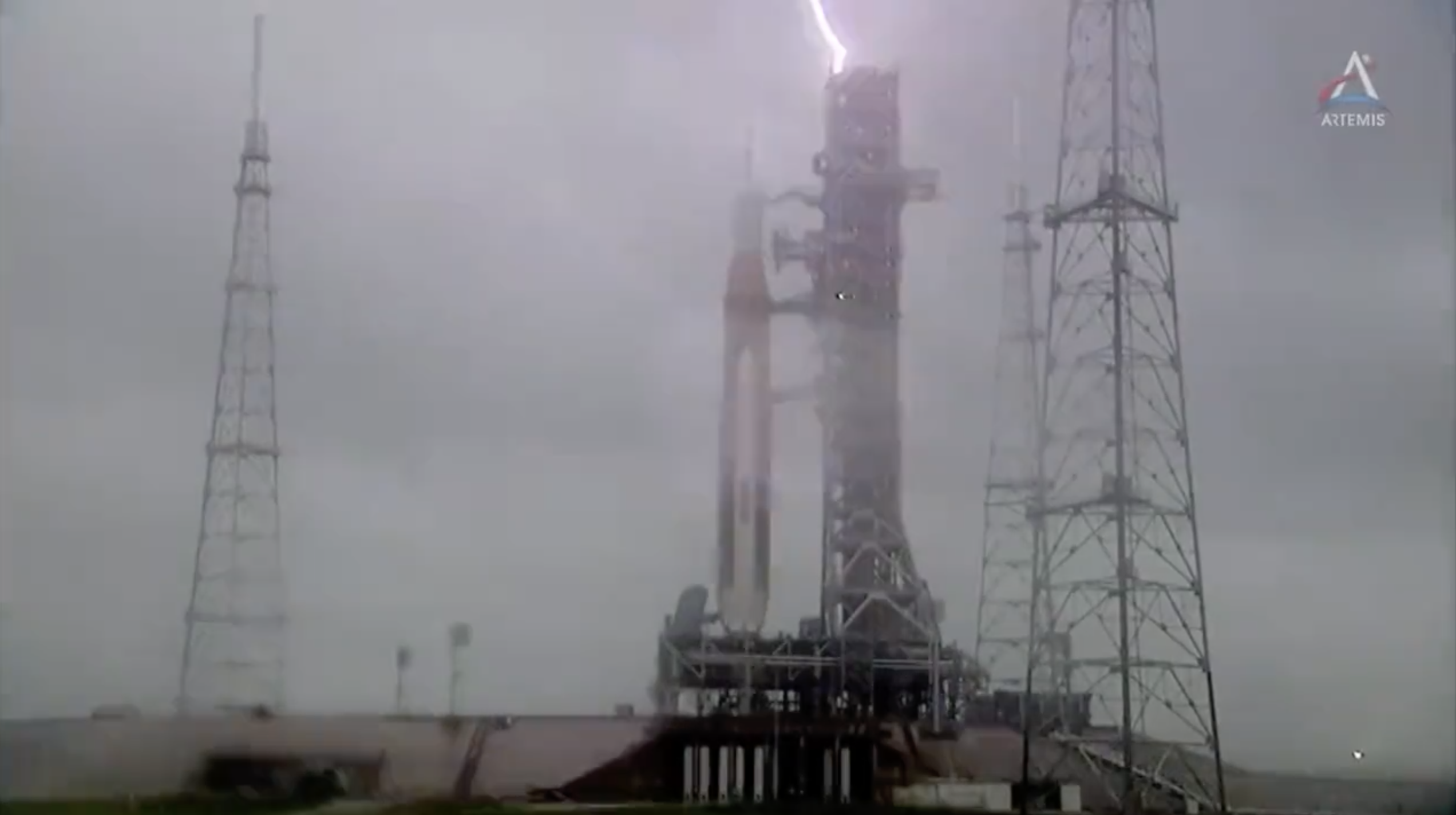Lightning strikes NASA's Artemis 1 moon megarocket launch pad during test
Lightning struck the launch pad home of NASA's giant Artemis 1 moon rocket several times on Saturday (April 2), but the rocket was in good health as technicians worked through a critical test.
Four lightning strikes hit the area around Launch Pad 39B, where NASA's first Space Launch System (SLS) megarocket was undergoing a three-day fueling test known as a "wet dress rehearsal" for its Artemis 1 mission to the moon later this year. The rocket is protected from lightning by three towers and a catenary wire structure to divert strikes to the ground away from the booster.
The first three lightning strikes were relatively low-power events, NASA officials wrote in an update late Saturday. But the fourth strike, which hit "tower one" of the lightning protection system, was more powerful. You can see a clip of the lightning strike from NASA's live video stream of the fueling test.
Live updates: NASA's Artemis 1 moon mission
Related: NASA's Artemis 1 moon mission explained in photos

"1 of the strikes last night was the strongest we have seen since we installed the new lightning protection system," wrote Jeremy Parsons, NASA's deputy manager of the Exploration Ground Systems, who is live tweeting the test for the agency. "It hit the catenary wire that runs between the 3 towers. System performed extremely well & kept SLS and Orion safe. Glad we enhanced protection since Shuttle!"
Parsons said NASA upgraded Pad 39B's lightning protection system to include better shielding against strikes and better separate electrical current from launch hardware. Each of its towers is topped with a fiberglass mast and the catenary wires to divert lightning away from the rocket and its service structure, he added.
"The new system also has an array of sensors, both on the ground and the mobile launcher, will help determine the rocket's condition after a nearby lightning strike, which can prevent days of delays," Parsons wrote in a separate post.
Get the Space.com Newsletter
Breaking space news, the latest updates on rocket launches, skywatching events and more!
At the time of the lightning strikes on Saturday, the Artemis 1 SLS rocket's core stage and its Orion spacecraft were powered up, but the rocket's side-mounted solid rocket boosters and an interim cryogenic propulsion stage were off, according to a NASA update.
Early Sunday, NASA Artemis 1 launch controllers met to review data from the lightning strikes and the progress of the wet dress rehearsal, ultimately giving the "go" to begin fueling the Space Launch System rocket at 7:20 a.m. EDT (1120 GMT). Just under five hours later, NASA called off the fueling test due to a problem with ground equipment on the rocket's mobile launch platform.
This weekend's wet dress rehearsal test began April 1 and is a full launch countdown practice run for the Artemis 1 mission. During the test, ground crews will fill the core stage with 700,000 gallons of super-cold liquid oxygen and liquid hydrogen propellant.
Artemis 1 is NASA's first SLS mission under the agency's Artemis program to return astronauts to the moon by 2025 or so. The Artemis 1 flight will be an uncrewed trip around the moon to test the Space Launch System and its Orion crew capsule, which is carrying a bevy of experiments and a mannequin covered with sensors.
NASA will provide an update on the results of the Artemis 1 fueling test in a press conference on Monday (April 4) at 11 a.m. EDT (1500 GMT).
Email Tariq Malik at tmalik@space.com or follow him @tariqjmalik. Follow us @Spacedotcom, Facebook and Instagram.
Join our Space Forums to keep talking space on the latest missions, night sky and more! And if you have a news tip, correction or comment, let us know at: community@space.com.

Tariq is the Editor-in-Chief of Space.com and joined the team in 2001, first as an intern and staff writer, and later as an editor. He covers human spaceflight, exploration and space science, as well as skywatching and entertainment. He became Space.com's Managing Editor in 2009 and Editor-in-Chief in 2019. Before joining Space.com, Tariq was a staff reporter for The Los Angeles Times covering education and city beats in La Habra, Fullerton and Huntington Beach. In October 2022, Tariq received the Harry Kolcum Award for excellence in space reporting from the National Space Club Florida Committee. He is also an Eagle Scout (yes, he has the Space Exploration merit badge) and went to Space Camp four times as a kid and a fifth time as an adult. He has journalism degrees from the University of Southern California and New York University. You can find Tariq at Space.com and as the co-host to the This Week In Space podcast with space historian Rod Pyle on the TWiT network. To see his latest project, you can follow Tariq on Twitter @tariqjmalik.









